|
11/11/13--Khajuraho
After breakfast, we meet our local guide, Singh. He is a cute little guy, perfect with his impish grim for showing us around the tenth century Khajuraho, and explaining some of the Kama Sutra (love techniques). Kama is the Love God and Sutra is the art of making love. Kama Sutra was written 3-4 centuries before Christ. We are surrounded by sculptures that show love, sex and affection between male, female and even a few animals tossed in for good measure. Singh told us that the priests used the figures as teaching tools to show the town folk new positions and the role of love and prana energy in Hindu eroticism. Bill and I see many similarities with the figures in Angkor Wat in Cambodia – only the Cambodian Aspara dancers are a bit more modest.

Singh at Khajuraho |

Singh at Khajuraho |

Khajuraho |

Khajuraho |
It is a beautiful day, great for exploring the temples. They were built between the 9th and 11th centuries. Some of the temples were built by the warrior kings of the Chandela dynasty. When the warriors weren’t fighting, they were carving sexy statues to cover the walls of the temples, striking a perfect balance between architecture and sculpture. Aside from being soldiers, they were exceptional artisans and horny, I would imagine. All seriousness aside, the figures are carved so beautifully that one can make out the emotions of the faces and the reactions from the body gestures.
During its heyday, Khajuraho was covered with about 85 temples over 21 square kilometers. Only about 25 temples remain today. The temples belong to two different religions – Hinduism and Jainism. They depicted what sex was like in medieval times – not at all what one could possibly imagine. There are 84 positions depicted, but not one missionary position – maybe that came later with the missionaries.
By the 16th century, Khajuraho lost all its importance and faded into an obscure village. It was until 1838, when Captain T. S. Burt rediscovered the temples in the middles of the forest and put them back on the world scene, much to the chagrin of Queen Victoria. Luckily, most of the indecent and offensive figures remain, making Khajuraho a real hot spot. After the Taj, it’s the second most visited place in Indian.
I roam around the grounds with Bill giggling (because I’m immature) and snapping photos. Here’s just some of the hundreds of photos I captured:

Khajuraho |

Khajuraho |

Khajuraho |

Khajuraho |

Khajuraho |

Khajuraho |

Khajuraho |

Khajuraho |

Khajuraho |

Khajuraho |

Khajuraho |

Khajuraho |

Khajuraho |

Khajuraho |

Khajuraho |

Khajuraho |

Khajuraho |

Khajuraho |

Khajuraho |

Khajuraho |

Khajuraho |

Khajuraho |

Khajuraho |

Khajuraho |

Khajuraho |

Khajuraho |

Khajuraho |

Khajuraho |

Khajuraho |

Khajuraho |
After wonders of “Medieval Sex Guides,” we travel to the Jainist town of Orchha. I’d never heard of Jainism, another most interesting religion until I came to India.
Jainism -- A little background Ė Optional Reading:
Jainism is a religion that originated in India around the same time as Buddhism. There are about 5 million followers of Jainism, mostly living in India. Jains do not believe in an all-powerful Supreme Being or creator, but rather in a universe of scientific laws. Mahavira was a man that lived during the time of the Buddha. He was also a prince that gave up everything to find spiritual understanding. He was very influential and helped to make the religion what it is today.
The main goal of Jainism is to reach enlightenment (they call Moksha) and end the cycle of birth-death-rebirth. The people who have reached enlightenment are called Tirthankaras. Jains believe karma directs our reincarnation and also affects our body. Jains believe in the true equality of ALL life with a major emphasis on non-violence. Jains believe ALL souls, including ALL plants and animals, are equal because they all can be free of the birth-death-rebirth trap and attain enlightenment. To do this, they must conquer all temptations and inner enemies such as anger, greed and pride by practicing non-attachment with the material world and by living a peacefully disciplined lifestyle.
Compassion for all life, human and non-human, is important to Jainism. Human life is viewed as a rare opportunity for the soul to reach enlightenment, so to kill any person, no matter what crime he may have committed, is considered absolutely unacceptable. It is the only religion that requires monks AND followers to be vegetarian. The Jain diet excludes most root vegetables such as potatoes, onions, and garlic because eating these foods kills the entire plant. They would prefer foods like apples because eating an apple doesn’t kill the tree.
Jain saints always remain naked, even in the days of extreme cold and extreme heat. They don’t us blankets or heaters or air conditioners, etc. to protect from heat or cold. Gandhi once said, “The ideal state of a human being is nudity, a naked person is completely faultless and innocent.”
They pluck the hair of their head, beard and mustache by their own hands every two to four months. They don’t use razors to avoid killing the micro and macro organism.
They eat food and water once a day in a standing position.
They never lie.
They have no possession, no shelter, no monastery. They always continue to move from one place to another. They don’t use any vehicle, always moving on their bare feet.
They are allowed only two things -- a brush made of peacock feathers to sweep the ground, removing insects, etc. so they don’t step on them and kill them; and a jar of coconut water to clean themselves.
|
I am fascinated by this strange religion and see a few naked Jains walking about. Although they are supposed to be blissful, they look like automatons covered in dust and there is nothing sexy about their nakedness.
Prahbu takes us to their Jain Shri Shantinath Temple. It’s an old dusty, but very important temple in the Jain religion. I try to make sense of this strange religion – but feel myself judging too much. You know what they say? “Judge not least ye (think that’s how you spell it) be judged!”

Jain Shri Shantinath Temple |

Jain Shri Shantinath Temple |

Jain Shri Shantinath Temple |

Jain Shri Shantinath Temple |
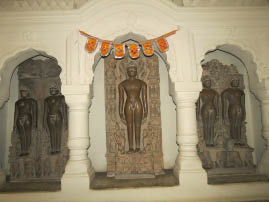
Jain Shri Shantinath Temple |

Jain Shri Shantinath Temple |
Next Prahbu leads us out back to the Parshwanath Temple and Adinath Temple built in the middle of the 10th century).
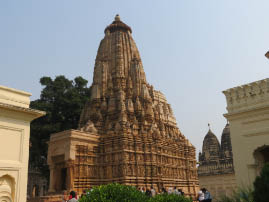
Jain Temple |

Jain Temple |

Jain Temple |

Jain Temple |

Jain Temple |

Jain Temple |
We have time for lunch at the hotel before we go to the airport for our 40 minute flight to Varanasi. The plane is late and the waiting room is crowded, but we make the best of it. I read the inflight magazine.
We arrive in Varanasi in time to drop our bags at the Radisson Varanasi Hotel and then hop on the bus to go into the holiest of Hindu cities. It’s THE PLACE where many pilgrims of all castes and creeds come to make a purify dip in the Ganges to be cleansed of their sins. You make it to the Mighty Ganges (dead or alive) and you get a “Get out of Jail Free” card. The living take a dip and the dead have someone float their ashes away down the Ganges and voila – You go straight to heaven (or Paradise), no need to pass “GO,” never having to return to this miserable earthly world. You are simply released from the eternal cycle of birth and rebirth. People come from miles around to make their pilgrimage to the Ganges. The old especially flock to the Ganges to die. It’s a city where folks are dying to die. Nothing like it anywhere.
Varanasi -- A little background – Optional Reading:
Varanasi is one of the oldest cities in the world with a written history dating back more than 4,000 years. The city’s original name, Kashi, is derived from the word “Kasha” meaning bright (City of Light). The present name is a combination of the two rivers on its northern and southern boundaries -- Varune and Asi.
According to legend, Varanasi was created by Shiva -- God of Gods and the cosmic lord. There’s Hindu gods a’plenty adding to Varanasi’s intense spiritual atmosphere. Every day in Varanasi is never ending religious festivals with devotees from every part of the globe crowding the narrow streets and spilling over into the Ganges.
|
On the bus, our local guide, Krishna, tells us about Varanasi, his home town. Krishna looks so much like Omar Sharif, oozing with charm that I rename him “Omar.” His classy delivery style overpowers any content he’s trying to convey. I just go with the “Stepforth Guide” and try to absorb his trance-like vibe.
We disembark from the bus by the outskirts of old Varanasi. A series of rickshaws are in line waiting to take us deeper into the old city. The rickshaw drivers negotiate the busy streets with lots of craziness to entertain us – scooters, cars, weirdoes on a spiritual mission, lazy dogs, goats, and arrogant cows who own the place. The sun is setting quickly making all the scenes even more Felliniesque.

Varanasi |

Woo and Kai in Varanasi |
The rickshaw takes us as far as possible into the heart of Old Varanasi. Next we go on foot, joining the crowds flowing down the narrow alleys to the river. We must dash to the banks of the holy Ganges in time to join the mobs for the nightly service – to give thanks for the day past and to ask for blessings for the next day. Omar and Prahbu have their work cut out getting a bunch of old farts through the dark streets crawling with people, animals of all sorts, tripping dangers, and unspeakable filth. We keep our eyes focused on our group as we snake our way through bizarreness. Finally we emerge by the river and rush down a series of steps (ghats) to join the “happening” at the edge of the riverbank.
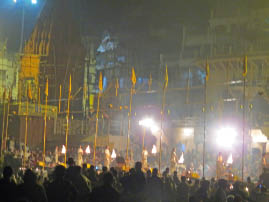
Varanasi |

Varanasi |
Huge “football” stadium type lights illuminate the area. The camera-buffs in the group are desperate to start snapping photos – but Omar and Prahbu must corral us and get us to our small boat. Boats are packed tightly along the river bank full of people. Our fearless leaders find the “captain” of our little wooden boat. We must scurry across several floating boats in order to board “our ship.” The place is eerie with the worshippers on shore and the glowing light on the quiet polluted Ganges.
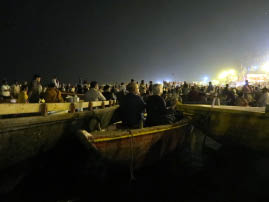
Varanasi |

Varanasi |

Varanasi |

Varanasi |
Omar directs the boat away from the boat traffic jam to point out the ancient buildings that line the river – forts, palaces, temples, crematories just above the ghats (steps to the river). Varanasi has about 100 ghats – many are for bathing, but some for cremation. We sit quietly in the slightly rocking boat in the chill of the night and take in all the wonders. Omar points out a fire that is actually a cremation taking place – and at a very high class crematorium. One family owns it and has a monopoly on the cremation business for centuries. A real a gold mine -- they’ve cleaned up on body disposals.

Varanasi |
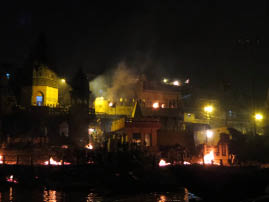
Varanasi |
Omar sets the mood and then we each light a little candle in small woven baskets (along with a marigold) and release it into the murky water. This ritual is called an aarti. It is an offering to the Goddess Ganga, also affectionately referred to as Maa Ganga, goddess of the most holy river in India. Lines of flickering candles floating gently downstream in the sacred river added magic to the night.
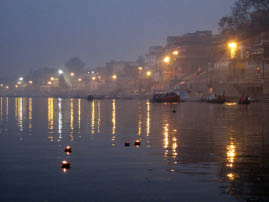
Varanasi |
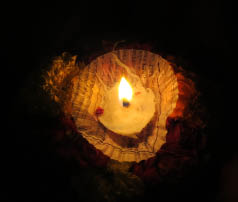
Varanasi |
The rowing effort of a couple of young lads turned our boat around and we head back up the river. Their mission was to get us close to the two main Ďstagesí on the Dasaswamedh Ghat where we watch the aarti, the sacred light ceremony, on the Ganges. Itís an elaborate ritual observed every night, playing to a massive crowd. During the ceremony, about a dozen young priests in saffron-colored robes offer incense and fire; ring bells and chimes, chant and end it all by blowing into conical shella. Tourists view the ceremony from the ghat or boats on the river (as we did). The darker it gets the more the yellows, reds and oranges shine in the gleam of candelabras. It is a spectacular sound and light show, but it isnít simply for the tourists, this is the culture, thousands of years old.

Varanasi |

Varanasi |

Varanasi |

Varanasi |

Varanasi |

Varanasi |
After the priests blow their shells, the party is over. Our group heads back through town to meet our waiting rickshaws. It was like walking through a movie set, where you expect to see all manner of weird sights and characters – but what we are seeing is real.

Varanasi |

Varanasi |
As we walk along the exotic, holy and horrific streets, a pesky peddler of postcards strikes up a conversation with Bill. (Bill should know better.) In no time, I’m drawn in. That little guy is in my face telling me how beautiful I am. Come on, I’m not beautiful – I’m just walking dollars to him. He is a real pain in the ass. At one point, a pack of angry dogs begin barking – a territorial thing, I’m sure. The vicious growling sounds add a layer of tension and confusion to the hood. In the midst of this, Brian (the doctor) trips on a street barricade and went down hard, face first. Terrifying scene. Turns out he is OK – but that could have been a real disaster. I shove the postcard peddler away, but he said he’d see us in the morning – I’m afraid it’s not over yet.
We find our rickshaws crammed into a fenced in back lot with about 100 or more rickshaws, all with tourists trying to find their driver and get the heck out of there. We Westerners need our space and lots of it. Finally, the rickshaw parking lot empties out and we’re on our way to our big, comfortable bus with more space for our traveling comfort.
Finally, we arrive back at the hotel which affords even more space. The Radisson Varanasi, is grandiose, classy and lovely. Compared to what we see on the streets of India, it’s absolutely out of this world. (I’m not worthy … but I’m not complaining.)
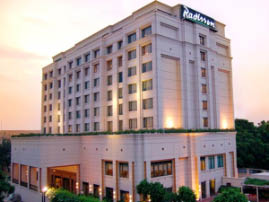
Radisson Varanasi |

Radisson Varanasi |
11/12/13--Varanasi
Wake up call comes at 4:45 in the morning. We hurriedly dress, then stumble onto the bus at 5:15. Under Omar’s guidance, we drive back to the Ganges for sunrise and all its glory. I’m happy we get to see the holy place washed in light.
For our early morning outing, we retrace our steps from the night before. The bus takes us to a rickshaw and then we walk to the Ganges. Along the way, I buy a plastic bottle to collect some of the river water for Katy, my good friend from India who lives un San Diego.
Wouldn’t you know it -- that pesky peddler of postcards spots us right away and picks up where he left off last night, making a complete nuisance of himself. To get rid of him, Bill finally buys a set of postcards – and not a minute too soon. We are not happy with his disruption, and he is not happy with the pitiful sale -- definitely a lose-lose situation.
I’m glad when he’s gone so I can focus all my attention on the mysterious surroundings. After I get beyond the trash and the cows, I see all sorts of people, a couple of whacko holy guys thrown in for good measure. All have fascinating faces. I spot a naked Jain waking up with his naked body covered with ashes. (We are not allowed to photograph nude holy guys. Not a problem -- there is nothing sexy about him!)
To the constant sounds of chanting, our group files down the steps to our boat. I immediately stick my hand, holding the plastic bottle, into the water to gather the precious water. To my surprise, the water is warm. I wonder what kinds of micro parasites are hitching a ride on my body now. All that river bathing for the Indians seems perfectly safe, but WASP wussies like us – BEWARE. Omar tells us the story about one adventurous Swedish guy who joined the crowds for a swim and only lasted a couple weeks – died back in Sweden. Even the best medical care couldn’t save him – hope he went on to Paradise.
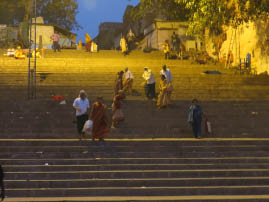
Varanasi |

Varanasi |

Varanasi |

Varanasi |

Varanasi |

Varanasi |
We cruise along the Ganges in our little old boat watching the town wake up. There are so many sights to behold. Omar points out the ancient, timeless structures – temples, forts, palaces, crematoriums, etc. -- some built 450 years ago. It is an ageless, unreal place, especially in the quiet morning mist.

Varanasi |

Varanasi |

Varanasi |

Varanasi |

Varanasi |

Varanasi |

Varanasi |

Varanasi |

Varanasi |

Varanasi |
Worshippers arrive at the ghats at dawn to take a ritual dip in the cold, polluted, dirty water of the great holy Ganges to welcome the new day and wash away impurities. We see people doing yoga and people sending out little baskets of candles, incense and marigolds making their offerings to Shiva and Mother Ganges. I am amazed to see several people doing huge loads of laundry in the river and laying them out to dry. Apparently laundry businesses who wash the items in the holy (and very unclean) water command a higher price – crazy! A few tourists are mixed into the early morning action as they jockey to get the perfect picture. Meanwhile, the natives and worshippers are quietly centered within, not like the Fellini crowd that gathered here last night.

Varanasi |

Varanasi |

Varanasi |

Varanasi |

Varanasi |

Varanasi |

Varanasi |

Varanasi |

Varanasi |

Varanasi |

Varanasi |

Varanasi |

Varanasi |

Varanasi |

Varanasi |

Varanasi |

Varanasi |
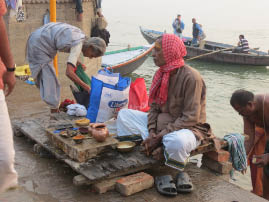
Varanasi |

Varanasi |

Varanasi |

Varanasi |

Varanasi |

Varanasi |

Varanasi |

Varanasi |

Varanasi |
One side of the riverbank is loaded with visual stimulation -- people, movement, and sound all within an ancient backdrop. The other side of the river is void of such motion. At just the right time, Omar directs our attention to the opposite shore to see the sun rising over a peaceful Ganges. He even coaches us when to get the perfect shot of the sun reflecting on the river. I took a gazillion photos – here’s a handful that give you the idea.

Varanasi |

Varanasi |

Varanasi |

Varanasi |
Finally, our time on the river is over. We disembark and come across a low rent crematorium (unlike the high class one we saw last night). We see the flames still burning on a couple of dearly departed’s with their families watching quietly without a tear or a mournful sigh to be had. They believe this is a happy time for the deceased and if we grieve and mourn and carry on, we’re holding onto to the deceased who will not be able move on into their next life. Most women in the grieving families are forbidden to attend the ritual because, as we all know, women (who still have emotions) are more likely to cry. (By the way, we are band from photographing the cremation. When we got too close, Omar tells us to put our cameras away. I manage to capture the essence of the “from ashes to ashes” process in these photos.

Varanasi |

Varanasi |

Varanasi |

Varanasi |
That was it – We were done with the river and done with the cremations. It was time to weave our way through the shantytown and back to the bus. On the way, we stop for some chai tea and watch the narrow streets filling with people – worshippers, shop owners, school children, holy men and of course, the most honored and healthy cows. We see some water buffalo – but they are not holy and do not get the same respect as their fellow species, the cow. The morning market is just opening and life is beginning to flow again in this dirty, exotic, swirling, and dizzying world.

Varanasi |

Varanasi |

Varanasi |

Varanasi |

Varanasi |

Varanasi |

Varanasi |

Varanasi |

Varanasi |

Varanasi |

Varanasi |

Varanasi |

Varanasi |

Varanasi |
We board the bus and drive just a few blocks until the traffic comes to a standstill. We walk to the Bharat Mara (Mother India) temple, dedicated not to any god or goddess, but to the Mother India (the Ganges River). Mahatma Gandhi dedicated this rather new temple in 1936. The main attraction of this temple is a huge, intricate bas relief map of the Indian subcontinent, carved out of white marble. In his slow hypnotic state, Omar points out India’s key geographic wonders – rivers, Himalayans, Khyber Pass, etc. He saves the main focus, the Ganges River for last. Its waters cut across India like the shape of a woman with her arms outspread and her legs firmly planted on the ground. Her great big heart is centered in the heart of India. I find it fascinating that Omar mixes his description using poetry and science. After a while, I do grow weary of Omar’s cadence. Listening to his soft tones sends my type “A” personality plummeting to about a “D.” I must get out of there quick and back to my old self.
I’m a live again as soon as I spot some good ole Indian craziness to behold, and marvel at and PHOTOGRAPH! Right by our bus I find a most entertaining gentleman, a real showman, waiting for us with his giant cobra and two trained monkeys. The cobra wiggles, one monkey dances while the other one plays the drums. However, their biggest trick is working the crowds and collecting rupees from us.

Varanasi |

Varanasi |

Varanasi |

Varanasi |

Varanasi |

Varanasi |
We arrive back at the hotel at 9 am just in time for the last breakfast seating. We must find our way through a never-ending maze of buffet tables before we chow down massive quantities of food. Life is so tough for us! We sit with our pals, Ann and Bran. We’re gonna miss them!
Fueled up and ready to go again, we visit Sarnath, the ancient Buddhist learning center of Sarnath. Here, Gauama Buddha (the first and real Buddha) preached his first sermon to his disciples (all 5 of them). A huge, but very plain stupa, marks the spot. The area was once a tranquil deer park, which is fitting because Buddha was once a deer here before he was re born as a human. (Hey, how do they know all this?)
This is indeed the birthplace of Buddhism – not Buddha. Buddha was born to a royal family in Nepal, not India. Several groups were sitting on the lawn at the base of the stupa chanting – very pleasant. Many are on pilgrimages. Others were busy getting ready for a huge festival on November 17th, stringing lights and lanterns and flags and tidying up the place.

Sarnath |

Sarnath |

Sarnath |

Sarnath |
In another area, we see a large Bodhi tree grown from a sapling of the famous tree in Sri Lanka, where Buddha achieved enlightenment. Now it’s crawling with white robed folks on a pilgrimage from Sri Lanka.
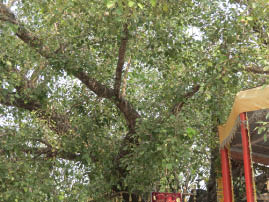
Sarnath |
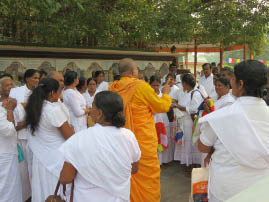
Sarnath |
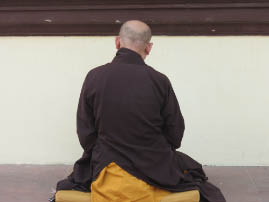
Sarnath |

Sarnath |
We enter the main temple and see the reproduction of Buddha getting a paint touch up here and there in time for the upcoming celebration. (We see the original Buddha in the museum on our next stop.)

Sarnath |

Sarnath |

Sarnath |

Sarnath |
At almost every Buddhist temple are paintings or murals of Buddha’s life. Believe me, we’ve seen plenty, but the murals in this temple were done by a Japanese artist and very stylish – I really liked his interpretation. Omar points out every mural as he explains Buddha’s crazy life (his first life, that is). Basically, the story goes something like this:
- Buddha’s Mother dreams that she will have a great son.
- Buddha is born from his mother’s side.
- At age 19 Buddha leaves the palace and riches and his wife who just delivered their first son.
- Away from the palace and riches, Buddha learns about the pain and agony in the world.
- Buddha refuses to eat.
- Buddha struggles with demons and desires.
- Buddha finds enlightenment under the Bodhi tree, escaping from the tree of life
- Buddha shares the simple lessons he learned from his enlightenment by giving his first sermon just out the temple door.
- Buddha does some more good stuff and then dies at age 80.
Story goes that Buddha made a few more incarnations later to give the world a boost just when we needed it most. (Hey, where’s that guy today?)
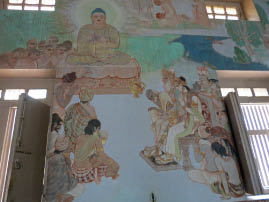
Sarnath |
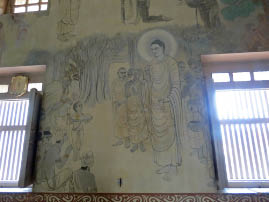
Sarnath |
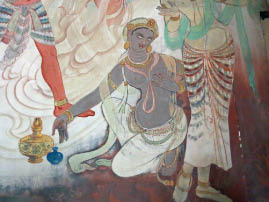
Sarnath |
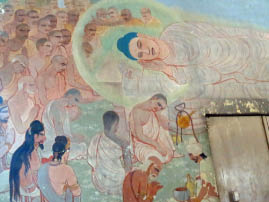
Sarnath |
We leave the temple and deposit our well-used temple socks, never having to put them on again.
Our next stop is the Sarnath Museum. The museum building is not that impressive. It has only a few rooms with at first sight, unimpressive statues and simple display cases. We must leave our things at the door – absolutely no photos allowed – so I borrowed these 2 from the internet.
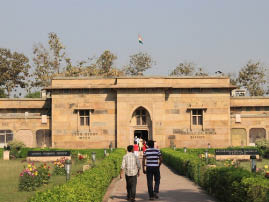
Sarnath Museum |
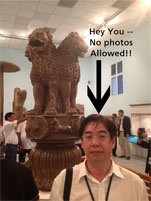
Sarnath Museum |
Omar knows a lot about this stuff and is excited about showing us the great treasures of Buddhist art, all housed within this nondescript building. Prominently displayed in the main entry is Emperor Ashoka’s Lion Capital – the National Emblem of India. The pillar, comprised of 4 lions, stood 17 meters over the capital city from 273 BC to 236 BC. Ashoka was a great leader crazy about the arts and set India on its way to becoming a first class culture. The Lion Capital image is printed on today’s rupee.
We walk down the hall to find the Teaching Buddha, removed from the temple we had just visited. (A cheap copy is being painted in there temple today – I have a picture to prove it.) What makes this Buddha so cool is that when viewed from the front, Buddha is smiling. However, move to each side and discover in profile, Buddha is a serious guy.
Omar pointed out the evolution of art and style from the various pieces. Some from the 2nd century were inspired by the massive monuments of the Egypt. Three or four centuries later, the style changes to a more dedicate, graceful classical Greek design and then finally to India’s own designs – buxom, curvy ladies exuding sexuality. Thank you Omar, I would not have a clue about the changing, developing designs if it weren’t for your explanations.
Tired from a long day of sightseeing, we must suffer one more stop at yet another silk-weaving workshop. We watch a room of about 5 guys sitting at their looms, weaving beautiful brocades, strand by stand. I look at the dusty room and monotonous work, and think I would lose my mind (and / or my eye sight) doing such a tedious job. After 20 minutes, we are guided to the second floor room where we are offered drinks of our choice (including beer) to be lulled into buying. I pick out one simple scarf while waiting for the beer I ordered. It comes just as we are leaving. I ask to take a beer and run, but my sense of humor was not well received and they didn’t hand it over.

Silk-weaving Workshop |

Silk-weaving Workshop |

Silk-weaving Workshop |

Silk-weaving Workshop |
The weaving shop is just around the corner from our hotel, so we walk back to our room and try to take a nap before a lecture on India set for 4 pm. We are exhausted from the very busy day, but aren’t accustomed to naps so we just fool around until talk time.
The Indian gentleman who gives the talk is a professor type who speaks so elegantly that I don’t mind that I can’t understand his accent. Bill is enthralled with his knowledge and asks lots of economic and political questions, and issues dealing with Pakistan.
Afterwards, a small group of us (Judy, David, Sue, Ed, and Ann) peel off and head for the bar. We have 30 minutes before it’s time for the gals to be fitted for a sari for our Farewell Dinner. However, it takes 25 minutes to get our beers, so us gals gulp down the beers while the guys linger at the bar. The ladies head down to Maryann’s room for our fittings. We pick from an array of brightly colored saris, and one by one, an assistant from the hotel wraps us up. We giggle and act like we’re in high school getting ready for the big prom. It’s a fun girlfriend experience.

Wearing Sari |

Wearing Sari |

Wearing Sari |
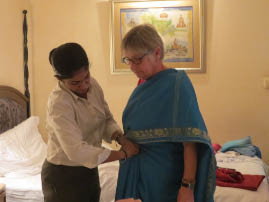
Wearing Sari |

Wearing Sari |

Wearing Sari |

Wearing Sari |

Wearing Sari |

Wearing Sari |
We are late for our Farewell dinner at The Kebob restaurant in the hotel. It is a lavish event – no buffet! The servers bring one dish after another – mostly kebobs. I enjoy the heck out of the food. Prahbu asks each of us to share some of our thoughts about India. It is a delightful, articulate group and everyone gushes over Prahbu’s leadership. He is a terrific guide and we are lucky to have him. Afterward the feast and farewells, some of us go into the kitchen to see how the chef makes the food. Lovely night, lovely experience. We head for our rooms, sad to have the trip end.

Vistiing Kitchen |

Vistiing Kitchen |
11/13/13--Varanasi to New Delhi
The day starts at 7 with a basic yoga and meditation class. The teacher is very good and leads us through a few simple postures. It feels good to do some yoga again – any yoga. Our instructor is a doctor of some type who recommends specific diet and exercise for you, based on your body type – fire, air, water, etc. I didn’t pursue a body type analysis, but went right to breakfast, where another big feast awaits us under the lids of those buffet dishes.
After breakfast, we go to the room and get things organized. Bill relaxes and I hit the road on foot seeking gifts for friends and family. I come across just the spot with a great assortment of scarves. I spend an hour or more going through the items and asking how much … how much. Finally, I make my purchases and go back to the room.
We leave the hotel at 1 and head to the Varanasi airport for an hour flight to New Delhi. We must kill an hour or more before boarding, but luckily the plane is on time. It’s packed with a group of very loud Italians. I work on my journal while Bill chats with Maryann.
We get to our hotel, Parkland Grand, in Delhi around 6. The rest of the group will be departing in the middle of the night. Bill and I choose to stay one more day in Delhi to explore it on our own. The group is ready to go home – and so are we. The hotel is crappy, but we’ll make the best of another day.

Nancy's Tevas |
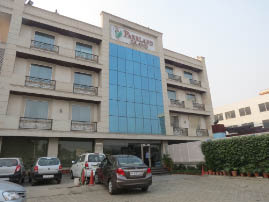
Parkland Grand Hotel |
We join Ann, Bran, Judy and David for dinner in the hotel. With no lunch, we’re hungry and ready for a beer, our nightly ritual. Bad news, the hotel doesn’t have a license to serve beer in the restaurant. It takes forever to get our meals. We shared the tiniest pizza, but the rest of the gang has pity on us and shares their food. We say our good-byes and come see us any times – then go back to our room where we watch “Waltz with Bashir” We are totally brain dead and feeling down by the cramped, noisy room. We have been spoiled rotten by OAT and all the other incredible hotels we’ve stayed on this trip.
11/14/13--New Delhi
Bill gets up at 6 to get our seats on the plane to London … and then to San Diego. I am so happy he takes care of all those annoying issues that come with travel.
We have breakfast at 7 and then try to go for a walk in the neighborhood. All the newness and glitz of India has faded. We hear blaring horns. We see dust and dirt and trash along with piles of feces—cow, dog (and probably some human). We constantly watch for any vehicle that may end our lives. We make the walk short and come back to our dark little room. I catch up on the journal while Bill tries to download some files.
I take a long hot shower, using enough water to clean all the people in the neighborhood. Gluttony and guilt follow me all over India.
We have lunch at the hotel – a bad lunch. Bill orders a lamb burger that we suspect causes great, delayed illness that haunts Bill for weeks to come. At 2, our driver (arranged by Prahbu) picks us up for our last day in India. Having our fill of temples and forts and castles, we want to see modern India.
Our first stop is a glitzy “Kingdom of Dreams” mall and two huge stage theatres. We see “The Gypsy Prince” – the most “knock-your-eyeballs-right-out-of-their-sockets” place. Although we didn’t understand Hindu, we got the basic plot. The production was out of this world with hundreds of dancers in a full-on Bollywood format. When the stage was overflowing with swirling glitz and color, they dropped even more performers down from the ceiling. The choreography from both above and below was very clever. The energy of the performers, along with the heavy beats of the drums, whipped the audience up into a frenzy. The show was well worth the $30 ticket. (Sorry, no photos allowed.) However, the audience was loaded with junior high kids on a special outing. The star-struck teens brought with them their own energy.
After the show, we go to the Disneyland-type mall right next door. We walk through the clever shops and cafes and have a beer at a bar with the theme of Bollywood. Great fun.
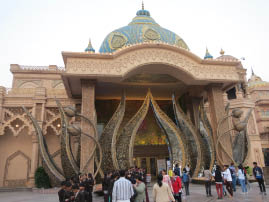
Kingdom of Dreams |

Kingdom of Dreams |

Kingdom of Dreams |

Kingdom of Dreams |

Kingdom of Dreams |

Kingdom of Dreams |

Kingdom of Dreams |

Kingdom of Dreams |
We meet our driver at 6 and go to the Ambience Mall – much like our Fashion Valley, only times 10 nicer. The trunk of our cab is checked by security guards when we arrive at the front gate. That’s life in India. The mall is a huge new 5-story palatial building with marble floors. Our main mission is not to shop – all the shops are too up-scale and carry common global luxuries – nothing that says “Ethnic and India.”
We find the multiplex theatre. We are frisked again at the door. I must leave my camera battery at the check point. We study the movie selections and pick “Krisna 3". Krisna is a super hero in India. Of course, some Bollywood is mixed in. We buy the Gold Pass for the total experience. With my hearing impairment, I thought the ticket guy said it was “free beer” – instead of “it’s premiere.” My world is so crazy and India makes it crazier.
We enter the theatre with big, comfy, reclining red leather chairs. There is a blanket on the seat and a tray holding drinks. The movie, although in Hindi, is a delightful experience – taking super heroes to the next level.
We enjoy a couple hours of posh movie viewing and then have dinner at The Punjab Grill in the mall. We order Indian food – and it is the best in all of India. We pig out and then at 9:30 pm, waddle back to our cab to go to the hotel.
Here we drive on freeways – not on the back country bumpy roads we have come to love. The crazy Indian driving is the same, only now we are traveling at speeds of 60 or more where one can do grave damage.
At our yucky hotel, we take spit baths in the bathrooms and relax in the lobby until 11:30 pm when our driver returns to take us to the airport. We are completely out of rupees and our smallest US bill is $100. The bellhop takes pity on us and gives us a free bottle of water to use so that we can brush our teeth. Pretty sad – re-entry is always tough.
The airport at midnight is full and loud with a security guard at every corner to check your passport, tickets and pat you down. I’m going to miss these free mini massages. Small booths with curtains are installed for women frisking. Men get their pat downs right out in the open. Men also get to pee right out in the open as well.
After some trolling, we find a couple of lounge chairs and stretch out until we board our 9-hour flight to London at about 3:30 am. It is the worst flight we’ve encountered in some time – completely full and a couple of crying babies to add to the misery. A large Indian gal carrying a big bag with no sense of boundaries sits right between us. Her large arms keep changing the controls on my video monitor. Bill gets harassed by an Indian guy seated behind him. At 8:30 am, we arrive in London with a six-hour layover until our flight to San Diego. I go into auto pilot and try to make the best of it. This is grueling … but it only gets worse ….
We board the plane for San Diego at 2 pm with high hopes. Wrong again. It’s another packed flight and worse yet, we’re stuck on the tarmac for over 6 hours. The plane had an issue with the brakes, then an issue with fixing the computer bracket that broke while they were fixing the brakes. The flight attendants were understanding and felt very badly that they couldn’t serve drinks until we were airborne. Bill gets a severe case of Delhi-Belly and has the worst runs while locked in the cabin for 17 hours. He made several trips to the toilet and got very good at cleaning thme. Finally, just when we’re all at our wit’s end, we are cleared for takeoff. Only 11 hours in the air and then we’re home. The flight from hell!
We are late – nobody can make up 6 hours. Brian picks us at the airport after 11 pm. Terrible Day – but we’re home at last – Bill can now seek help from Western Medicine. I know the agony of the trip home will fade and we’ll remember one amazing adventure!
|











